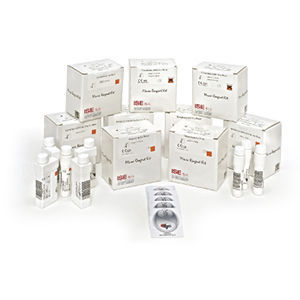
Solution reagent kit A-R0200001401 blood samplefor clinical chemistryliquid
Add to favorites
Compare this product
Characteristics
- Type
- solution
- Applications
- blood sample, for clinical chemistry
- Format
- liquid
- Tested parameter
- for LDL
Description
Product for use in the quantitative determination in vitro of the concentration of LDL
cholesterol in human serum or plasma. The results of the test must always be
interpreted in conjunction with the clinical context. For professional use only.
CLINICAL SIGNIFICANCE
Total cholesterol in humans is principally distributed between three major classes of
lipoproteins: VLDL (very low-density lipoproteins), LDL (low density lipoproteins) and
HDL (high density lipoproteins). An increase in the plasma levels of LDL cholesterol
constitutes one of the major risk factors for the development of coronary heart disease
(CHD). In humans, LDL are carriers which transport two thirds of the blood cholesterol,
having an important role in the formation of aterosclerotic plaques. LDL catabolism
takes place in the liver and peripheral tissues following interaction with specific highaffinity LDL receptors. The presence of these receptors has been demonstrated in most
cells, although they are more numerous in certain types, e.g. adrenocortical cells in
which LDL cholesterol acts as principle substrate for the synthesis of steroid hormones.
A defect in the process of removal of LDL or the superposition of low-density
lipoproteins, precursors of LDL, can cause an increased concentration of LDL in the
serum. The precipitation method for the determination of LDL cholesterol is little used
because the results are often inaccurate in the presence of high serum triglycerides
levels.
Catalogs
No catalogs are available for this product.
See all of ISE‘s catalogsRelated Searches
- Solution reagent kit
- Protein reagent kit
- Laboratory reagent kit
- Antibody
- Clinical chemistry reagent
- Clinical chemistry analyzer
- Blood sample reagent kit
- Automatic clinical chemistry analyzer
- Benchtop clinical chemistry analyzer
- Electrolyte reagent kit
- Blood clinical chemistry analyzer
- Enzyme reagent
- Clinical chemistry analyzer with ISE
- Serum clinical chemistry analyzer
- Random access biochemistry analyzer
- Biochemistry analyzer with touchscreen
- Plasma clinical chemistry analyzer
- Compact clinical chemistry analyzer
- Reagent for antigens
- Glucose reagent kit
*Prices are pre-tax. They exclude delivery charges and customs duties and do not include additional charges for installation or activation options. Prices are indicative only and may vary by country, with changes to the cost of raw materials and exchange rates.







